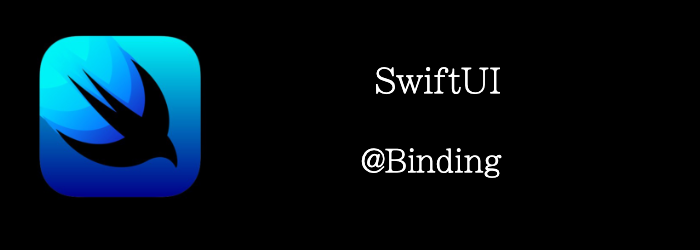 我们上一篇讲了@State,如果我们有其他VIew要修改我们的State呢?
我们上一篇讲了@State,如果我们有其他VIew要修改我们的State呢?
在TodoList demo 中,todos array是struct,是值类型,如果我们传递state到child view,那么传递的是值的copy。当child view修改array时,并不能反映到parent view的array中,所以也看不到变化。
SwiftUI通过@Binding解决这个问题,其本质上可以看成是生成一个对get和set方法的封装struct。
我们将沿用上一个TodoList的demo来看看@Binding的使用。
Getting ready
沿用上一个TodoList的项目,如果你新建项目的话,可以拷贝如下代码到项目。
struct Todo: Identifiable {
let id = UUID()
let description: String
var done: Bool
}
@available(iOS 15.0, *)
struct ContentView: View {
@State var todos = [
Todo(description: "review the first chapter", done: false),
Todo(description: "buy wine", done: false),
Todo(description: "paint kitchen", done: false),
Todo(description: "cut the grass", done: false),
]
var body: some View {
List($todos) { $todo in
HStack {
Text(todo.description).strikethrough(todo.done)
Spacer()
Image(systemName:todo.done ? "checkmark.square" : "square")
}
.contentShape(Rectangle())
.onTapGesture {
todo.done.toggle()
}
}
}
}
How to do it…
- 创建一个新的View来添加新的todo
@available(iOS 15.0, *)
struct InputTodoView: View {
@Binding var todos: [Todo]
@State private var newTodoDescription: String = ""
var body: some View {
HStack {
TextField("Todo", text: $newTodoDescription)
.textFieldStyle(.roundedBorder)
Spacer()
Button {
guard !newTodoDescription.isEmpty else { return }
todos.append(Todo(description: newTodoDescription, done: false))
newTodoDescription = ""
} label: {
Text("Add")
.padding(.horizontal, 16)
.padding(.vertical, 8)
.foregroundColor(.white)
.background(.green)
.cornerRadius(5)
}
}.frame(height: 60)
.padding(.horizontal, 24)
.padding(.bottom, 30)
.background(Color.gray)
}
}
- 将InputTodoView添加到界面上
var body: some View {
ZStack(alignment: .bottom) {
List($todos) { $todo in
HStack {
Text(todo.description).strikethrough(todo.done)
Spacer()
Image(systemName:todo.done ? "checkmark.square" : "square")
}
.contentShape(Rectangle())
.onTapGesture {
todo.done.toggle()
}
}
InputTodoView(todos: $todos)
}.edgesIgnoringSafeArea(.bottom)
}

How it works…
就像我们开头说的那样,children要修改parent的state,parent直接吧state传递给children是不行的,因为传递的是值的copy。
SwiftUI使用@Binding 创建一个双向绑定
- parent的变化会反应到children上
- children的变化也会反映到parent上
我们在children声明state时,使用@Binding,parent传入时传的是$state,而不是state。$操作符的意思是获取State结构体中的projectedValue属性。我们可以看到State结构体的projectedValue正是一个Binding类型。
var projectedValue: Binding<Value> { get }
深入了解@Binding
我们首先来看看,Binding结构体的Api
@frozen @propertyWrapper @dynamicMemberLookup struct Binding<Value>
// Creating a Binding
init<V>(Binding<V>)
init(get: @escaping () -> Value, set: @escaping (Value, Transaction) -> Void)
init(get: @escaping () -> Value, set: @escaping (Value) -> Void)
我们可以看到2点
- Binding是能够进行dynamicMemberLookup,也就是说我们能够使用
$state.someproperty这样的方式来进行访问,这返回什么呢?得看他的subscript是怎么实现的,我们稍后再看 - 我们看到初始化方法,就是get和set方法,正如开头说的那样。可以把Binding看成是get和set方法的一个封装。
有了这两点了解,我们来实现一个我们自己的@MyBinding。
首先,定义一个property wrapper,包含一个get和set方法。
@propertyWrapper
struct MyBinding<T> {
private let getValue: () -> T
private let setValue: (T) -> Void
var wrappedValue: T {
get {
return getValue()
}
nonmutating set {
setValue(newValue)
}
}
var projectedValue: Self { self }
init(getValue: @escaping () -> T, setValue: @escaping (T) -> Void) {
self.getValue = getValue
self.setValue = setValue
}
}
补全@MyState
我们来用一下试一试,补全下上一篇文章的@MyState
final class Box<T>: ObservableObject {
@Published var value: T
init(_ value: T) {
self.value = value
}
}
@propertyWrapper
struct MyBinding<T> {
private let getValue: () -> T
private let setValue: (T) -> Void
var wrappedValue: T {
get {
return getValue()
}
nonmutating set {
setValue(newValue)
}
}
var projectedValue: Self { self }
init(getValue: @escaping () -> T, setValue: @escaping (T) -> Void) {
self.getValue = getValue
self.setValue = setValue
}
}
@propertyWrapper
struct MyState<T>: DynamicProperty {
@ObservedObject var box: Box<T>
var wrappedValue: T {
get {
return box.value
}
nonmutating set {
box.value = newValue
}
}
var projectedValue: MyBinding<T> {
return MyBinding {
return box.value
} setValue: { newValue in
box.value = newValue
}
}
init(wrappedValue: T) {
self._box = ObservedObject(wrappedValue: Box<T>(wrappedValue))
}
}
struct ChildView: View {
//使用我们自己MyBinding
@MyBinding var text: String
var body: some View {
VStack {
Text("this is children: \(text)")
Button {
text = "\(Int.random(in: 200...300))"
} label: {
Text("change from child")
}
}
}
}
@available(iOS 15.0, *)
struct ContentView: View {
@MyState var text = "hello world123"
var body: some View {
VStack {
Text("\(text)")
Button {
text = "\(Int.random(in: 0...100))"
} label: {
Text("change")
}
ChildView(text: $text)
}
}
}

现在我们已经补全了@MyState,能够使用$text了。
实现dynamicMemberLookup
Ok,我们刚刚能够使用$text了,但是如果我们想要用$state.somePropert呢, 我们试一试
struct ChildView: View {
//我们改下chidlrenView,显示字符串的数量,也就是text.count
@MyBinding var textCount: Int
var body: some View {
VStack {
Text("this show textCount: \(textCount)")
}
}
}
struct ContentView: View {
@MyState var text = "hello world123"
var body: some View {
VStack {
Text("\(text)")
Button {
text = "\(Int.random(in: 0...100))"
} label: {
Text("change")
}
// 改下传参,但是报错了,因为我们的MyBinding不支持这种语法
ChildView(textCount: $text.count)
}
}
}
所以,我们用dynamicMemberLookup修饰下MyBinding。
@propertyWrapper
@dynamicMemberLookup
struct MyBinding<T> {
...
subscript<Sub>(dynamicMember keyPath: WritableKeyPath<T, Sub>) -> MyBinding<Sub> {
return MyBinding<Sub> {
return self.wrappedValue[keyPath: keyPath]
} setValue: { newValue in
self.wrappedValue[keyPath: keyPath] = newValue
}
}
}
我们来用一下:
struct ChildView: View {
@MyBinding var name: String
var body: some View {
VStack {
Text("name is: \(name)")
Button {
name = "child\(Int.random(in: 1...100))"
} label: {
Text("点击修改name")
}
}
}
}
struct Person {
var name = ""
var age = 20
}
@available(iOS 15.0, *)
struct ContentView: View {
@MyState var person = Person(name:"hello")
var body: some View {
VStack {
Text("person name:\(person.name) age: \(person.age)")
Button {
person.name = "parent\(Int.random(in: 200...300))"
} label: {
Text("change")
}
ChildView(name: $person.name)
}
}
}

不错,我们成功使用了$person.name。
至此,我们对Binding已经有了一定的了解,也知道了$操作符的原理,以及$state.someProperty的原理。